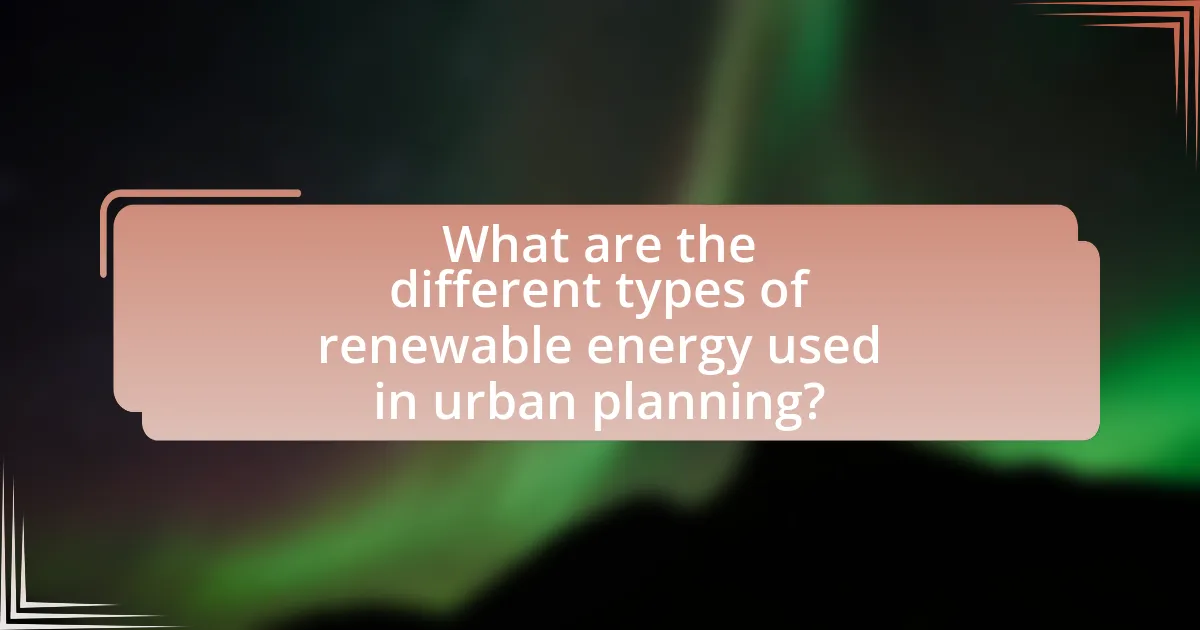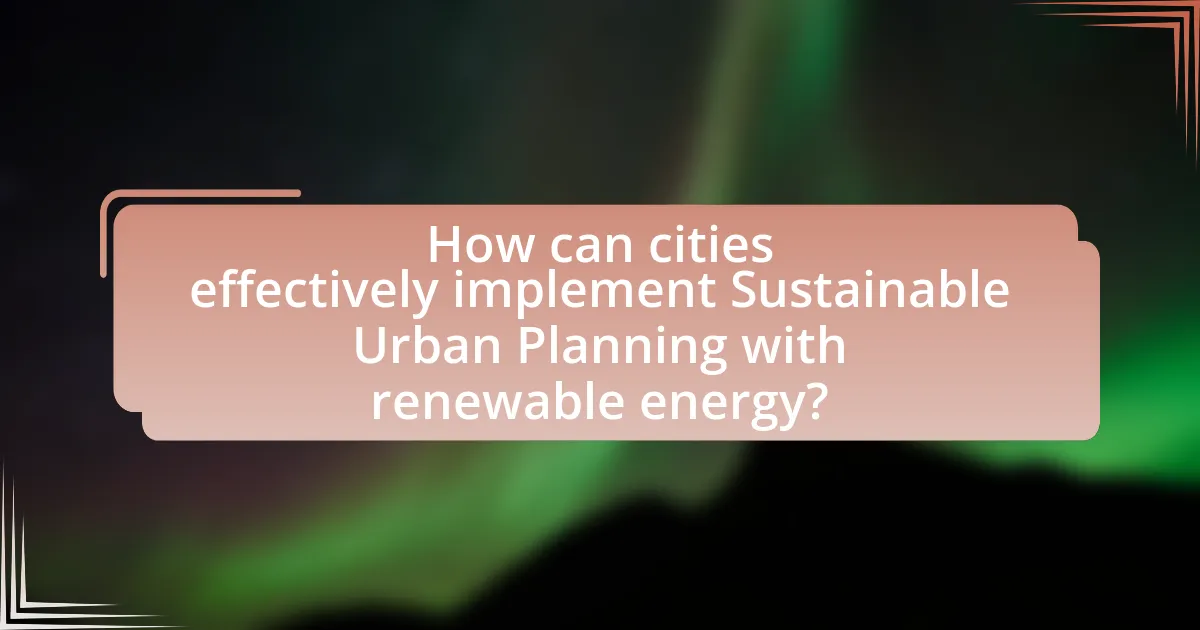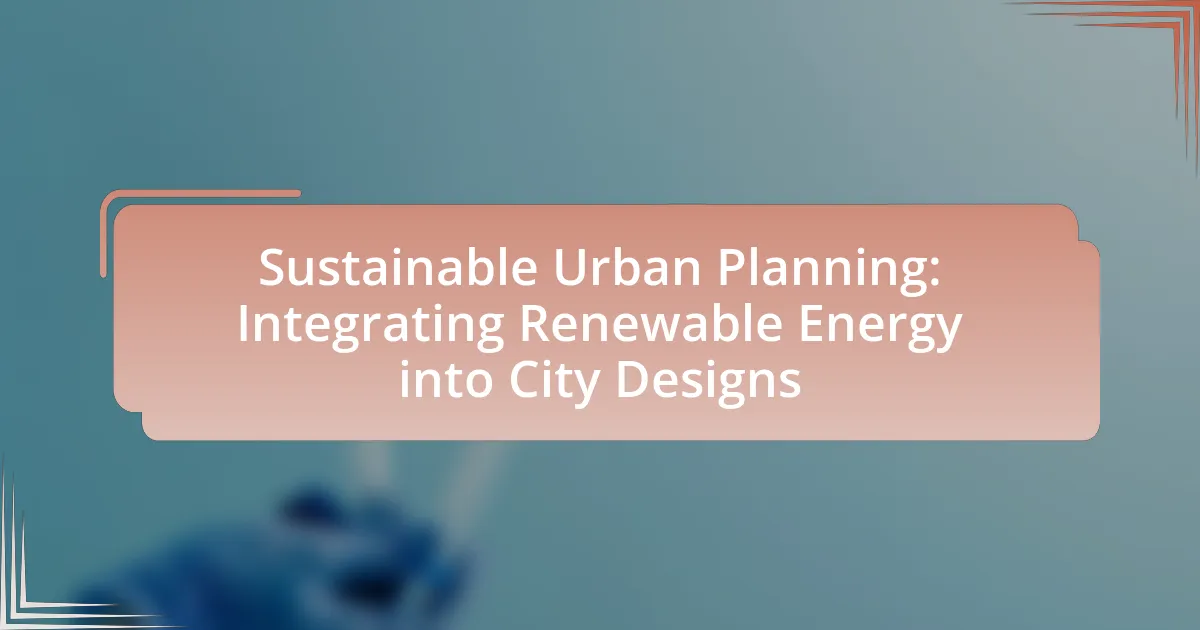Sustainable urban planning is a strategic approach that focuses on creating urban environments that prioritize environmental health, social equity, and economic viability. This article explores the significance of sustainable urban planning in addressing urbanization challenges, such as resource depletion and pollution, while enhancing community well-being. Key principles include efficient land use, renewable energy integration, and public transportation promotion. The article also examines the role of renewable energy sources, such as solar and wind, in urban designs, the challenges of their implementation, and successful case studies from cities like San Diego and Copenhagen. Additionally, it highlights best practices for balancing development with sustainability and the importance of community engagement in the planning process.

What is Sustainable Urban Planning and Its Importance?
Sustainable urban planning is a strategic approach to designing urban environments that prioritize environmental health, social equity, and economic viability. This planning method is essential because it addresses the challenges of urbanization, such as resource depletion, pollution, and social inequality, by promoting practices that reduce carbon footprints and enhance the quality of life for residents. For instance, according to the United Nations, over 55% of the world’s population lives in urban areas, and this figure is expected to rise to 68% by 2050, highlighting the urgent need for sustainable practices to manage urban growth effectively. Sustainable urban planning incorporates renewable energy sources, efficient public transportation, green spaces, and sustainable building practices, which collectively contribute to a resilient urban ecosystem.
How does Sustainable Urban Planning contribute to environmental goals?
Sustainable Urban Planning contributes to environmental goals by promoting efficient land use, reducing carbon emissions, and enhancing biodiversity. This planning approach integrates renewable energy sources, such as solar and wind, into urban designs, which decreases reliance on fossil fuels and lowers greenhouse gas emissions. For instance, cities that implement green building standards can reduce energy consumption by up to 30%, as reported by the U.S. Green Building Council. Additionally, sustainable urban planning encourages the development of green spaces, which not only improves air quality but also supports local ecosystems, thereby fostering biodiversity.
What are the key principles of Sustainable Urban Planning?
The key principles of Sustainable Urban Planning include efficient land use, integration of renewable energy, promotion of public transportation, and community engagement. Efficient land use minimizes urban sprawl and maximizes green spaces, which enhances biodiversity and reduces environmental impact. The integration of renewable energy sources, such as solar and wind, into city designs decreases reliance on fossil fuels and lowers greenhouse gas emissions. Promoting public transportation reduces traffic congestion and pollution, encouraging a shift towards more sustainable commuting options. Community engagement ensures that the needs and preferences of residents are considered, leading to more resilient and inclusive urban environments. These principles collectively contribute to creating sustainable cities that are adaptable to climate change and promote a high quality of life.
How does Sustainable Urban Planning impact community well-being?
Sustainable urban planning significantly enhances community well-being by promoting healthier living environments and fostering social cohesion. This approach integrates green spaces, efficient public transportation, and renewable energy sources, which collectively reduce pollution and improve air quality. Research indicates that access to parks and recreational areas can lead to increased physical activity, reducing obesity rates and related health issues. Furthermore, sustainable urban designs often prioritize mixed-use developments, which encourage community interaction and support local economies. A study by the American Planning Association found that communities with well-planned urban spaces report higher levels of satisfaction and lower stress levels among residents.
What role does renewable energy play in Sustainable Urban Planning?
Renewable energy is essential in sustainable urban planning as it reduces greenhouse gas emissions and promotes energy efficiency. By integrating renewable energy sources such as solar, wind, and geothermal into urban designs, cities can decrease their reliance on fossil fuels, leading to cleaner air and improved public health. For instance, a study by the International Renewable Energy Agency (IRENA) found that transitioning to renewable energy could reduce urban carbon emissions by up to 70% by 2050. This shift not only supports environmental sustainability but also enhances energy security and resilience in urban areas.
How can renewable energy sources be integrated into urban designs?
Renewable energy sources can be integrated into urban designs through the incorporation of solar panels, wind turbines, and green roofs within building architecture and public spaces. For instance, solar panels can be installed on rooftops and facades, providing clean energy while reducing reliance on fossil fuels. Wind turbines can be strategically placed in urban areas where wind patterns are favorable, contributing to the energy supply. Additionally, green roofs not only enhance insulation but also support solar energy systems by providing space for solar installations. According to the U.S. Department of Energy, cities that adopt these technologies can significantly reduce greenhouse gas emissions and improve energy efficiency, demonstrating the effectiveness of integrating renewable energy into urban planning.
What are the challenges of incorporating renewable energy in cities?
The challenges of incorporating renewable energy in cities include high initial costs, infrastructure limitations, regulatory barriers, and public acceptance issues. High initial costs can deter investment in renewable technologies, as cities often face budget constraints. Infrastructure limitations arise from the need to upgrade existing energy grids to accommodate renewable sources, which can be outdated and not designed for distributed energy generation. Regulatory barriers, such as zoning laws and permitting processes, can slow down the deployment of renewable energy projects. Additionally, public acceptance issues may stem from a lack of awareness or resistance to change, making it difficult to implement new energy solutions effectively. These challenges are documented in various studies, including the International Renewable Energy Agency’s report on renewable energy integration in urban environments, which highlights the need for comprehensive planning and stakeholder engagement to overcome these obstacles.

What are the different types of renewable energy used in urban planning?
The different types of renewable energy used in urban planning include solar energy, wind energy, geothermal energy, biomass energy, and hydropower. Solar energy is harnessed through photovoltaic panels and solar thermal systems, making it a popular choice for urban rooftops and public spaces. Wind energy is utilized through turbines, often placed in urban outskirts or on tall buildings to capture wind currents. Geothermal energy taps into the Earth’s heat for heating and cooling buildings, particularly in areas with geothermal resources. Biomass energy, derived from organic materials, can be used for heating and electricity generation in urban settings. Hydropower, while more common in rural areas, can be integrated into urban planning through small-scale hydroelectric systems in rivers or canals. These renewable energy sources contribute to reducing carbon emissions and promoting sustainability in urban environments.
How do solar energy systems function in urban environments?
Solar energy systems function in urban environments by converting sunlight into electricity through photovoltaic panels installed on rooftops or integrated into building designs. These systems capture solar radiation and convert it into usable energy, which can power homes, businesses, and public infrastructure. In urban settings, the efficiency of solar energy systems can be enhanced by utilizing available roof space and optimizing panel orientation to maximize sunlight exposure. According to the U.S. Department of Energy, urban areas can significantly reduce their carbon footprint by adopting solar technologies, with studies indicating that cities can achieve up to a 30% reduction in greenhouse gas emissions through widespread solar adoption.
What are the benefits of solar energy for city designs?
Solar energy provides significant benefits for city designs by promoting sustainability, reducing energy costs, and enhancing urban aesthetics. The integration of solar panels into buildings and public spaces can lead to a decrease in reliance on fossil fuels, contributing to lower greenhouse gas emissions. According to the U.S. Department of Energy, solar energy can reduce electricity bills by up to 70% for residential and commercial buildings, making it an economically viable option for urban areas. Additionally, solar installations can improve the visual appeal of cities when designed thoughtfully, incorporating green roofs and solar canopies that blend with the urban landscape. These benefits collectively support the goals of sustainable urban planning by fostering energy independence and resilience in city designs.
What are the limitations of solar energy in urban settings?
The limitations of solar energy in urban settings include space constraints, shading from buildings, and regulatory challenges. Urban environments often have limited roof space available for solar panels due to high-density construction, which restricts the amount of solar energy that can be harnessed. Additionally, taller buildings can cast shadows on solar installations, significantly reducing their efficiency and energy output. Regulatory challenges, such as zoning laws and building codes, can also hinder the installation of solar energy systems, making it difficult for urban planners to integrate renewable energy effectively into city designs.
What is the role of wind energy in urban planning?
Wind energy plays a crucial role in urban planning by providing a sustainable and renewable energy source that can reduce greenhouse gas emissions and dependence on fossil fuels. Integrating wind energy into urban designs allows cities to harness local wind resources, contributing to energy efficiency and resilience. For instance, cities like San Diego have implemented wind energy projects that supply clean power to local grids, demonstrating the feasibility and effectiveness of such integration. Additionally, the use of wind turbines in urban areas can enhance energy security and promote economic development through job creation in the renewable energy sector.
How can wind energy be effectively harnessed in cities?
Wind energy can be effectively harnessed in cities through the installation of vertical-axis wind turbines (VAWTs) and the integration of wind energy systems into urban infrastructure. VAWTs are particularly suitable for urban environments due to their ability to capture wind from any direction and their lower noise levels compared to traditional horizontal-axis turbines. Studies indicate that urban wind energy systems can generate significant power; for instance, a VAWT can produce between 1 to 10 kW, depending on its size and wind conditions. Additionally, incorporating wind turbines into building designs, such as rooftop installations, can optimize space and enhance energy efficiency. Urban planning that prioritizes wind corridors and minimizes obstructions can further increase the effectiveness of wind energy harnessing in cities.
What are the potential drawbacks of wind energy in urban areas?
The potential drawbacks of wind energy in urban areas include noise pollution, aesthetic concerns, and limited space for installation. Noise pollution from wind turbines can disrupt the quality of life for residents, as studies indicate that sound levels can reach up to 50 decibels, which is comparable to a quiet suburban area but can still be intrusive. Aesthetic concerns arise as urban landscapes may not accommodate the visual impact of large turbines, leading to opposition from local communities. Additionally, urban areas often have limited space for the installation of wind turbines, which can restrict the potential for energy generation; for instance, the American Wind Energy Association notes that urban wind projects typically generate less energy compared to rural counterparts due to lower wind speeds and turbulence caused by buildings.

How can cities effectively implement Sustainable Urban Planning with renewable energy?
Cities can effectively implement Sustainable Urban Planning with renewable energy by integrating renewable energy sources into their infrastructure and urban designs. This involves incorporating solar panels, wind turbines, and geothermal systems into buildings and public spaces, which can significantly reduce carbon emissions and energy costs. For instance, cities like San Diego have adopted policies that require new buildings to include solar energy systems, resulting in a 30% increase in solar installations from 2015 to 2020. Additionally, urban planners can design mixed-use developments that promote energy efficiency and reduce reliance on fossil fuels, as seen in the Vauban district of Freiburg, Germany, where 50% of energy needs are met through renewable sources. By prioritizing renewable energy in zoning laws and incentivizing green building practices, cities can create sustainable environments that support both ecological health and economic growth.
What strategies can cities adopt for successful integration?
Cities can adopt strategies such as developing comprehensive renewable energy policies, enhancing public transportation systems, and fostering community engagement to achieve successful integration of renewable energy into urban designs. Comprehensive renewable energy policies provide a framework for investment and implementation, ensuring that cities prioritize sustainable energy sources. Enhancing public transportation systems reduces reliance on fossil fuels and promotes the use of electric vehicles, which can be powered by renewable energy. Fostering community engagement involves educating residents about renewable energy benefits and encouraging participation in sustainability initiatives, which can lead to greater acceptance and support for integration efforts. These strategies collectively contribute to a more sustainable urban environment, as evidenced by cities like San Diego, which has successfully integrated solar energy into its infrastructure through policy and community involvement.
How can public policies support renewable energy in urban planning?
Public policies can support renewable energy in urban planning by establishing regulatory frameworks that incentivize the adoption of clean energy technologies. For instance, policies such as tax credits, grants, and subsidies for solar panels and wind turbines encourage both developers and homeowners to invest in renewable energy systems. Additionally, zoning laws can be modified to facilitate the integration of renewable energy infrastructure, such as solar farms and green roofs, into urban landscapes. Research from the International Renewable Energy Agency indicates that cities with supportive policies can increase renewable energy capacity by up to 30% within a decade, demonstrating the effectiveness of strategic policy implementation in promoting sustainable urban energy solutions.
What role do community stakeholders play in the planning process?
Community stakeholders play a crucial role in the planning process by providing input, feedback, and support that shape sustainable urban development. Their involvement ensures that the needs and preferences of the community are considered, leading to more effective and accepted planning outcomes. For instance, studies show that projects with active stakeholder engagement are 30% more likely to succeed, as they reflect the community’s values and priorities. This collaborative approach not only enhances transparency but also fosters trust between planners and the community, ultimately resulting in more sustainable and resilient urban designs that integrate renewable energy effectively.
What are some successful case studies of cities integrating renewable energy?
Some successful case studies of cities integrating renewable energy include San Diego, California, and Copenhagen, Denmark. San Diego has committed to running on 100% renewable energy by 2035, implementing extensive solar energy projects and energy efficiency programs, which have resulted in a significant reduction in greenhouse gas emissions. Copenhagen aims to become the world’s first carbon-neutral capital by 2025, utilizing wind energy to supply over 40% of its energy needs and investing in district heating systems that incorporate renewable sources. These cities demonstrate effective strategies for integrating renewable energy into urban planning, showcasing measurable impacts on sustainability and emissions reduction.
What lessons can be learned from these successful implementations?
Successful implementations of integrating renewable energy into city designs demonstrate the importance of collaboration among stakeholders. Effective partnerships between government, private sector, and community organizations lead to innovative solutions and shared resources, enhancing project viability. For instance, cities like San Diego have successfully integrated solar energy by engaging local businesses and residents, resulting in a 50% increase in solar installations over five years. Additionally, these implementations highlight the necessity of adaptive planning, where cities must remain flexible to incorporate new technologies and respond to changing environmental conditions. Evidence from the European Union’s Horizon 2020 initiative shows that cities adopting adaptive strategies have improved energy efficiency by up to 30%. Lastly, successful projects emphasize the value of public awareness and education, as informed citizens are more likely to support and participate in renewable energy initiatives, leading to greater overall acceptance and success.
How do these case studies inform future urban planning practices?
Case studies on integrating renewable energy into urban planning inform future practices by providing evidence-based strategies that enhance sustainability and efficiency. For instance, the implementation of solar panels in urban areas has demonstrated a significant reduction in energy costs and carbon emissions, as seen in cities like San Diego, where a 20% decrease in energy expenses was reported after solar integration. Additionally, these case studies highlight the importance of community engagement in planning processes, ensuring that renewable energy solutions meet local needs and preferences, which has been shown to increase public support and participation in projects. By analyzing successful examples, urban planners can adopt best practices, mitigate potential challenges, and create more resilient, energy-efficient cities.
What best practices should cities follow for Sustainable Urban Planning?
Cities should prioritize mixed-use development, efficient public transportation, green spaces, and renewable energy integration for sustainable urban planning. Mixed-use development promotes walkability and reduces reliance on cars, which lowers greenhouse gas emissions. Efficient public transportation systems, such as buses and trains, can significantly decrease traffic congestion and pollution, as evidenced by cities like Copenhagen, where public transport accounts for 62% of all trips. Incorporating green spaces enhances biodiversity and improves residents’ mental health, with studies showing that access to parks can reduce stress levels. Finally, integrating renewable energy sources, such as solar panels and wind turbines, into city designs can lead to a significant reduction in carbon footprints, as demonstrated by San Diego’s commitment to 100% renewable energy by 2035.
How can cities balance development and sustainability effectively?
Cities can balance development and sustainability effectively by implementing integrated urban planning that prioritizes renewable energy sources and efficient resource management. This approach involves designing infrastructure that minimizes environmental impact while accommodating growth, such as utilizing solar panels, wind turbines, and green building materials. For instance, cities like San Diego have adopted policies that mandate a percentage of energy used in new developments to come from renewable sources, resulting in a significant reduction in greenhouse gas emissions. Additionally, incorporating green spaces and promoting public transportation can enhance urban livability while reducing reliance on fossil fuels. Studies show that cities that invest in sustainable practices not only improve their environmental footprint but also boost economic resilience and community well-being.
What are the common pitfalls to avoid in urban planning?
Common pitfalls to avoid in urban planning include neglecting community engagement, failing to consider environmental impacts, and overlooking infrastructure needs. Neglecting community engagement can lead to developments that do not meet the needs or desires of residents, resulting in opposition and project failure. Failing to consider environmental impacts can result in unsustainable practices that harm local ecosystems, as seen in cities that have experienced flooding due to poor drainage planning. Overlooking infrastructure needs, such as transportation and utilities, can create bottlenecks and reduce the effectiveness of urban designs, as evidenced by cities that struggle with traffic congestion and inadequate public services.


